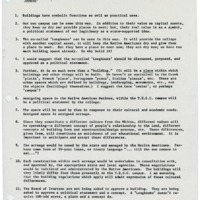Notes Concerning the Native American Center to be Established on the T.E.S.C. Campus
Item
-
Title
-
Notes Concerning the Native American Center to be Established on the T.E.S.C. Campus
-
Date
-
1981
-
extracted text
-
12/4/81
Notes Concerning the Native American Center to be Established on the T.E.S.C.
Campus.
1.
Buildings have symbolic functions as well as practical uses.
2.
Our own campus can be seen·this way. In addition to their value as capital assets,
they keep us dry and provide places to meet; but, their real value is as a symbol,
a political statement of our legitimacy as a state-supported idea.
3.
The so-called 'Longhouse' can be seen in this way. It will provide the college
with another capital asset, it will keep the Native Americans dry and give them·
a place to meet. But they have a place to meet now; they are dry now; we have too
much building space already. So why build it?
4.
I would suggest that the so-called 'Longhouse' should be discussed, proposed, and
approved as a political statement.
5.
Further, it is so much more than a "building." (It will be a place within which
buildings and other things will be built. We haven't an equivalent to the Greek
'platia', French 'place', Portuguese 'praca', Italian 'piazza', etc. These are
urban spaces which are defined by buildings, landscaping, monuments, etc., not
the objects (buildings) themselves~) I suggest the term 'center', or perhaps
'campus'?
6.
Assigning space to the Native American Nations, within the T.E.S.C. campus will
be a political statement by the college.
7.
The space will be used by them in response to their cultural and academic needs.
Assigned space is assigned acreage.
8.
Since they constitute a different culture from the Whites, different values will
be operating--a different con~ept of people's relationship to the land, different
concepts of building form and construction/design process, etc. These differences,
given form, will constitute an enrichment of our educational environment. It is
important to anticipate and accept these differences.
9.
The acreage would be owned by the state and managed by the Native Americans. Perhaps some form of 99-year lease, or treaty language ·" ••• till the sun ceases to
set ••• "?
10. Each construction within such acreage would be undertaken in consultation with,
and approval by, the appropriate state and local agencies. Those negotiations
would be initiated and administrated by the Native Americans. The buildings will
very likely differ from those presently on the T.E.S.C. campus. I am assuming.
that the building regulations· which apply will admit expression of those cultural
differences.
11. The Board of Trustees are not being asked to approve a building. They are being
asked to approve a political statement and a concept. A 'Longhouse' doesn't require 100-odd acres, a place and a concept do.
�-2-
12.
They are being asked to assign a large amount of the campus land without knowing
precisely what form the use will take. This is difficult. I would suggest that
discussion of the following would clarify things:
(Objectives)
A.
What are the purposes, goals, objectives, etc. of this
understanding?
(Behavior)
B.
What are the activities necessary to achieve them?
(Environment)
c.
What is the quantity of land required by them?
(Structure)
D.
What is the schedule of those activities (relation between
activities in space and time) 1
(Resources)
E.
What resources need be brought to bear?
,.
Philip Harding
 1973-86_NAS_8D38_02_29
1973-86_NAS_8D38_02_29